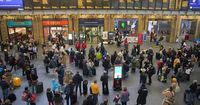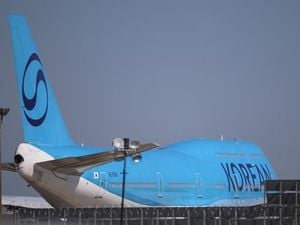London’s King’s Cross Station was evacuated on May 1, 2025, following a fire alarm that triggered significant disruption across the city and beyond. The incident occurred during peak travel hours, stranding thousands of commuters who were left waiting outside the usually bustling station while emergency services responded to the situation.
Shortly after 7:20 PM, Great Northern announced on X, formerly Twitter, that all lines from King’s Cross were blocked due to the evacuation. An LED sign at the entrance read: ‘Emergency. Do not enter,’ adding to the urgency and confusion among passengers. Eyewitness accounts described the scene as chaotic, with many people forced to exit the station as alarms rang out.
Journalist James Pierce reported on social media that “Kings Cross Station closed due to an unspecified emergency. Thousands of commuters now forced to wait outside.” Another commuter, Stephen Hill, shared his experience arriving at a “closed King’s Cross,” speculating that staff had been alerted to a fire. He humorously noted, “I got back to a closed King's Cross (I suspect we were the last train in) to see my first ever Inspector Sands incident in the wild.”
The term “Inspector Sands” refers to a discreet alert used by transport officials to notify staff of a potential fire without causing widespread panic. Following the evacuation, some commuters observed “normal staff and firefighters” moving about calmly inside the station.
Network Rail East Coast confirmed that the evacuation was a precaution due to reports of smoke linked to a retail unit within the station complex. A spokesperson stated, “King’s Cross was evacuated as a precaution earlier this evening for a brief period due to reports of smoke linked to a retail unit. The station is now reopened for passengers. Thank you to @londonfire for their quick response.”
Despite the reopening, Great Northern warned that the brief closure could lead to delays of up to 20 minutes for travelers during the busy evening rush hour. They advised passengers to check their journeys before traveling and suggested using alternative routes, including trains from nearby London St Pancras, which is just a five-minute walk away.
As news of the evacuation spread, it became clear that the incident had broader implications for travel across London and beyond. The station, which serves as a vital hub for national rail lines to Scotland, the Midlands, and the North, experienced a ripple effect of delays and cancellations. Commuters traveling to see the Tottenham Hotspur game against Bodo Glimt faced additional challenges, as many relied on King’s Cross for their journey.
Travel chaos ensued as platforms were cleared and trains halted. Passengers attempting to travel for work, tourism, or school found themselves stranded, with many seeking alternative transport options. The timing of the evacuation—during peak weekday evening traffic—particularly impacted business travelers and international tourists.
Emergency responders, including the British Transport Police (BTP), London Fire Brigade, and Transport for London (TfL), were quickly dispatched to the scene. The station was sealed off for over two hours while authorities investigated the reports of smoke. BTP released a brief update confirming that “officers are responding to reports of a security concern at King’s Cross Station,” advising the public to avoid the area until further notice.
While no immediate injuries were reported, the evacuation highlighted ongoing concerns about infrastructure preparedness and crisis communication within one of Europe’s busiest transportation centers. The incident also raised questions about the effectiveness of emergency protocols and the need for improved crowd control measures.
As the situation unfolded, social media lit up with posts showing the chaotic scene: packed platforms, closed escalators, and emergency vehicles stationed outside the station. Passengers expressed frustration over a lack of communication, with some stuck in queues outside while trains continued to arrive without access to platforms.
The King’s Cross evacuation is a reminder of the fragility of the UK’s travel infrastructure, particularly in a post-pandemic landscape where the tourism and travel sectors are still recovering. Analysts note that just a few hours of shutdown at a major station like King’s Cross can cost millions in lost productivity and bookings.
In the aftermath of the incident, hospitality and tourism stakeholders are urging the government to invest in smarter station security, automated alert systems, and better crowd management infrastructure to prevent similar situations in the future. The hope is that lessons learned from this evacuation will lead to enhancements that will better protect travelers and ensure smoother operations at one of the UK’s most vital transport hubs.
As of now, King’s Cross Station has reopened, but passengers are still advised to remain vigilant and check for updates regarding their travel plans. With the potential for ongoing delays and service alterations, it’s clear that the effects of this evacuation will be felt for some time.





